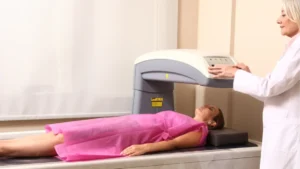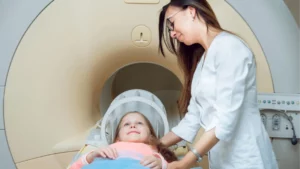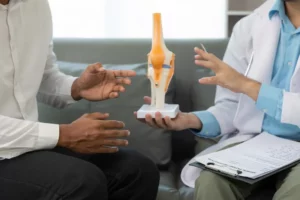Osteoporosis is a silent but serious condition that weakens bones, making them more susceptible to fractures. This condition often develops without any noticeable symptoms, earning it the nickname “the silent thief.” By the time a person experiences a fracture, significant bone loss may have already occurred. This is why early detection is paramount in managing and preventing the debilitating effects of osteoporosis. One of the most effective tools in diagnosing osteoporosis is the DEXA scan, a quick, non-invasive procedure that measures bone density with exceptional accuracy.
The importance of a DEXA scan for osteoporosis cannot be overstated. This advanced imaging technology not only helps in detecting osteoporosis early but also plays a vital role in monitoring bone health over time. With precise measurements of bone density, healthcare providers can assess an individual’s fracture risk, monitor the progression of bone loss, and tailor treatment plans accordingly.
What is a DEXA Scan?
A DEXA scan, or dual-energy X-ray absorptiometry, is a specialized medical imaging test designed to measure bone mineral density (BMD). Unlike standard X-rays, which can primarily detect fractures, a DEXA scan focuses on evaluating bone health by measuring the density of the bones. This scan is most commonly performed on areas where osteoporosis-related fractures are likely to occur, such as the spine, hip, and forearm.
The technology behind DEXA scans involves the use of two different X-ray beams that pass through the bones at different energy levels. By comparing the absorption of each beam, the machine can differentiate between bone and soft tissue, providing a precise measurement of bone density. This level of accuracy makes DEXA scans the gold standard for diagnosing osteoporosis and osteopenia. The ability to detect even subtle changes in bone density is crucial in identifying individuals at risk of fractures and in tracking the effectiveness of osteoporosis treatments over time.

Why DEXA Scans are Crucial in Detecting Osteoporosis
Detecting osteoporosis early is essential for preventing fractures and managing the condition effectively. A DEXA scan for osteoporosis offers several advantages that make it a crucial tool in diagnosis and treatment.
Accurate Measurement of Bone Density
One of the primary benefits of a DEXA scan is its ability to provide an accurate and reliable measurement of bone density. The results are typically expressed as a T-score, which compares the patient’s bone density to that of a healthy young adult of the same sex. A T-score of -1.0 or above is considered normal, between -1.0 and -2.5 indicates osteopenia (a condition of lower-than-normal bone density that is not yet severe enough to be classified as osteoporosis), and a T-score of -2.5 or lower suggests osteoporosis.
This precise measurement is essential for correctly diagnosing osteoporosis and differentiating it from osteopenia. Misdiagnosis or underestimation of bone loss can lead to inadequate treatment, increasing the risk of fractures. With a DEXA scan, healthcare providers can make informed decisions about the need for intervention, ensuring that patients receive the appropriate care to maintain bone health.
Early Detection
Early detection of osteoporosis through a DEXA scan can significantly reduce the risk of fractures and the associated complications. Since osteoporosis often progresses without any symptoms, many individuals are unaware they have the condition until they suffer a fracture. By the time a fracture occurs, the bones may have already become significantly weakened, leading to a longer recovery period and an increased risk of additional fractures.
A DEXA scan can identify bone loss before it leads to more serious complications. By detecting osteoporosis at an early stage, patients and healthcare providers have the opportunity to implement preventive measures such as medication, lifestyle changes, and dietary adjustments. These interventions can help slow the progression of bone loss, improve bone density, and reduce the risk of fractures.
Risk Assessment
The results of a DEXA scan not only diagnose osteoporosis but also play a critical role in assessing an individual’s risk of future fractures. The scan provides detailed information about bone density in specific areas of the body, allowing healthcare providers to identify the most vulnerable sites. This information is vital in developing a personalized treatment plan that addresses the patient’s specific needs and reduces the risk of fractures.
In addition to the T-score, the DEXA scan may also provide a Z-score, which compares the patient’s bone density to that of other individuals of the same age, sex, and size. A low Z-score may indicate that factors other than aging, such as an underlying medical condition or medication use, are contributing to bone loss. Understanding these risk factors enables healthcare providers to take a comprehensive approach to osteoporosis management, addressing all potential contributors to bone health.
One Step Diagnostic offers state-of-the-art DEXA scanning services to help you take control of your bone health.

Who should get a DEXA scan?
A DEXA scan is recommended for several groups of people, especially those at higher risk of osteoporosis. Identifying individuals who may benefit from a DEXA scan is crucial in preventing fractures and maintaining bone health. Here’s who should consider getting a DEXA scan:
Postmenopausal Women
The decline in estrogen levels after menopause significantly increases the risk of osteoporosis. Estrogen plays a crucial role in maintaining bone density, and its reduction can lead to rapid bone loss.
Men Aged 70 and Older
While osteoporosis is more common in women, men are also at risk, especially as they age. Bone density naturally decreases with age, making older men more susceptible to fractures.
Individuals with a History of Fractures
A history of fractures, particularly those that occur after minimal trauma, may indicate weakened bones and an increased risk of osteoporosis.
People with a Family History of Osteoporosis
Genetics play a significant role in bone health, and individuals with a family history of osteoporosis are at a higher risk of developing the condition themselves.
Those on Long-Term Steroid Therapy
Long-term use of corticosteroids can lead to bone loss, increasing the risk of osteoporosis and fractures. Individuals on these medications should consider regular DEXA scans to monitor bone density.
Individuals with Certain Medical Conditions
Conditions such as rheumatoid arthritis, celiac disease, and inflammatory bowel disease can increase the risk of osteoporosis. These conditions may affect bone metabolism, leading to bone loss over time.
The Process of a DEXA Scan
Undergoing a DEXA scan is straightforward and requires minimal preparation, making it a convenient option for assessing bone health. The process is quick, non-invasive, and painless, allowing patients to obtain crucial information about their bone density without significant disruption to their daily routine.
Preparation for the Scan
Preparation for a DEXA scan is simple and typically involves a few basic guidelines. Patients may be advised to avoid taking calcium supplements for 24 hours before the test, as high levels of calcium can interfere with the accuracy of the results. Additionally, it is recommended to wear loose, comfortable clothing without metal zippers, belts, or buttons, as these can interfere with the imaging process.
There is no need for fasting or special dietary restrictions before a DEXA scan, and patients can continue with their normal activities leading up to the appointment. The ease of preparation makes DEXA scans accessible and convenient for most individuals.
What to Expect During the Scan
During the scan, the patient will lie on a padded table while the DEXA machine passes a low-dose X-ray beam over the body. The scan typically focuses on areas where bone density is most critical, such as the spine, hip, and forearm. The entire process is painless and usually takes about 10 to 20 minutes, depending on the number of areas being scanned.
The patient is required to remain still during the scan to ensure accurate results, but there is no need for any invasive procedures or injections. After the scan is completed, patients can resume their normal activities immediately, with no downtime required.
Understanding the Results
Osteoporosis DEXA scan results are usually provided as a T-score and a Z-score. The T-score compares the patient’s bone density to that of a healthy young adult of the same sex, while the Z-score compares the patient’s bone density to that of others in the same age group. These scores help healthcare providers assess the patient’s risk of osteoporosis and fractures.
A T-score of -1.0 or above is considered normal, while a T-score between -1.0 and -2.5 indicates osteopenia, and a T-score of -2.5 or lower suggests osteoporosis. The Z-score can provide additional insights, particularly for younger individuals or those with underlying medical conditions that may affect bone density.
These results are crucial in guiding treatment decisions and monitoring the effectiveness of interventions over time. Healthcare providers use the information obtained from a DEXA scan to develop a personalized plan that may include medication, lifestyle changes, dietary adjustments, and regular follow-up scans to track progress.

Benefits of DEXA Scans
DEXA scans offer multiple benefits, making them an invaluable tool in managing bone health. The information provided by a DEXA scan is essential for early detection, ongoing monitoring, and effective treatment of osteoporosis.
Early Detection of Osteoporosis
As discussed, early detection through a DEXA scan can prevent osteoporosis from progressing and reduce the risk of fractures. Identifying bone loss at an early stage allows for timely interventions that can strengthen bones and improve overall bone health. This proactive approach is key to preventing the severe consequences of osteoporosis, including fractures and long-term disability.
Monitoring Bone Density
For individuals diagnosed with osteopenia or osteoporosis, regular DEXA scans are essential for monitoring bone density over time. These scans provide valuable information about how well the bones are responding to treatment and whether any adjustments need to be made. By tracking changes in bone density, healthcare providers can ensure that patients are receiving the most effective care to maintain or improve their bone health.
Fracture Risk Assessment
DEXA scans provide a detailed analysis of fracture risk, allowing for personalized care strategies to minimize this risk. The information obtained from the scan helps healthcare providers identify the most vulnerable areas of the body and develop targeted interventions to protect those areas. This level of detail is crucial in preventing fractures, particularly in individuals at high risk.
Non-Invasive and Quick
The non-invasive nature of the DEXA scan, coupled with its quick procedure time, makes it a comfortable and convenient option for patients. Unlike some other diagnostic tests, there is no need for injections, sedation, or extended periods of downtime. The entire process is straightforward and can be completed in a matter of minutes, allowing patients to obtain critical information about their bone health without significant disruption to their daily routine.
Low Radiation Exposure
DEXA scans use a very low dose of radiation, significantly less than a standard chest X-ray, making it a safe option for regular monitoring. The amount of radiation exposure during a DEXA scan is minimal, posing little to no risk to the patient. This low level of radiation makes DEXA scans an excellent choice for ongoing monitoring, as patients can safely undergo the test multiple times without concern.
Guiding Treatment Plans
The detailed information provided by a DEXA scan allows healthcare providers to tailor treatment plans to individual needs, optimizing outcomes. Whether the goal is to prevent bone loss, increase bone density, or reduce fracture risk, the data obtained from a DEXA scan is invaluable in developing an effective treatment strategy. By understanding the specific needs of each patient, healthcare providers can offer personalized care that addresses the unique challenges of osteoporosis.
The Role of DEXA in Preventing Osteoporosis-Related Fractures
DEXA scans play a crucial role in preventing fractures by providing early detection of bone loss and ongoing monitoring of bone health. By identifying individuals at high risk, healthcare providers can implement interventions such as medications, lifestyle changes, and dietary adjustments to strengthen bones and prevent fractures.
Regular follow-up scans ensure that treatment plans remain effective and are adjusted as needed to maintain bone health. The ability to track changes in bone density over time allows for a dynamic approach to osteoporosis management, ensuring that patients receive the most appropriate care at every stage.
Osteopenia vs Osteoporosis DEXA Scan
A DEXA scan is essential in distinguishing between osteopenia and osteoporosis, two conditions related to bone density loss. By accurately measuring bone mineral density, a DEXA scan helps healthcare providers diagnose these conditions, enabling early intervention and appropriate treatment to prevent further bone loss and reduce fracture risk.
Protect Your Bone Health with DEXA Scans at One Step Diagnostic
DEXA scans are an essential tool in the early detection and management of osteoporosis. By accurately measuring bone density, these scans help assess fracture risk, guide treatment, and monitor bone health over time.
Maintaining strong, healthy bones is crucial for overall well-being and quality of life. With the advanced technology and expertise available at One Step Diagnostic, you can trust that your bone health is in good hands. Don’t wait until it’s too late—schedule your DEXA scan today and take the first step toward preventing osteoporosis-related fractures.




